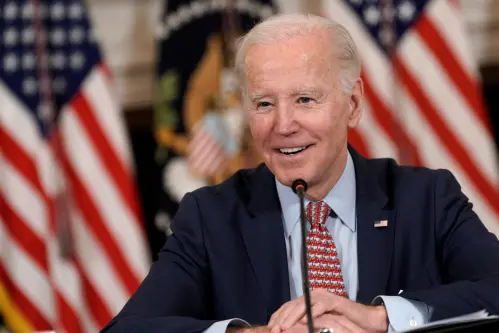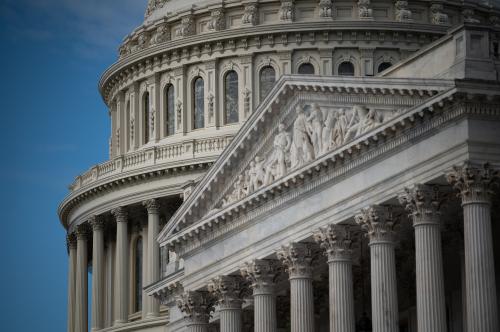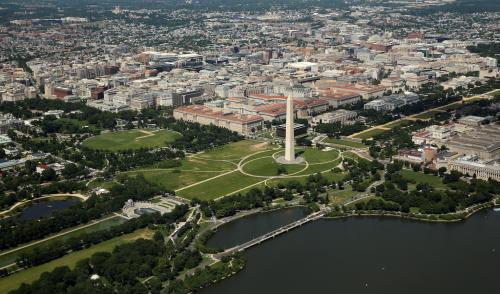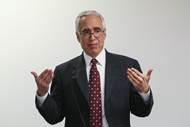This post is part of a series on the need for government reform and how to get it done. For more on this topic, visit the series page.
Presidential candidates have long ignored the federal bureaucracy as too boring for public consumption. Why attack duplication and overlap when there are new programs to promise? Why rail against the civil-service system when there are new layers to create? Why bother about building “a government as good as the people,” as Jimmy Carter promised in 1976, when it’s just as easy to say that “the era of big government is over,” as Bill Clinton declared in 1996? The answer is that Americans know the federal government needs repair, and they want it fixed, fast.[1]
The demand is clear as the Pew Research Center’s trend line on what Americans want from reform. Asked every few years about the need for federal government reform, the number of respondents who endorse “very major reform” has been at a statistical high-water mark for the past five years. As of late July, three out five Americans favored very major reform, two out of five said the federal government was basically sound and needs only some reform, and one out of five said it didn’t need any reform at all. Figure 1 shows the trend.[2]
Figure 1
The question, of course, is what the term “very major reform” means. It is easy to argue that demand for very major reform is simply an expression of party loyalty. As Figures 2 and 3 show, Republicans were almost twice as likely as Democrats to endorse very major government reform with Barack Obama still in the White House, and much less likely than Democrats to embrace very major reform with Trump battling for reelection.
Figure 2
Figure 3
Partisanship is not the only explanation in play, however. Deeper analysis of the Pew Research Center’s 2015 “Deconstructing Distrust” analysis suggests that standard measures of federal government performance also contribute to the demand—that is, whether respondents believe the federal government is almost always wasteful and inefficient, run by a few big interests, doing a poor job running its programs, and would be better run by ordinary people than elected officials.[3]
According to the Pew data, 93% of respondents who said the federal government needed very major reform also said the federal government was doing only a fair or a poor job running its programs, 92%% said they were angry or frustrated with the federal government, 90% said the federal government was pretty much run by a few big interests, 85% said they were dissatisfied with the way things were going in the country, 76% said they trusted the federal government in Washington only some of the time, 75% said the federal government is almost always wasteful and inefficient, 64% said ordinary Americans would do a better job in solving problems than elected officials; and 50% said voting by people like themselves does not really affect how government runs things.[4]
Government reform does not mean the same thing to all respondents nor do questions about reform always refer to the same target—e.g., the federal government versus the U.S. system of government. Yet, Americans seem to want very major reform whether asked about government reform or system change.[5] In March 2019, for example, the AP-NORC Center for Public Affairs Research asked 1,003 randomly-selected Americans to think about the “U.S. system of government” and what it might need. The answers are remarkably close to the survey results featured in Figure 1: 66% of the AP-NORC respondents favored major changes or complete replacement, compared with 61% of my respondents who favored very major changes, while 32% of the AP-NORC respondents favored minor or no changes compared with 31% of my respondents who favored only some reform. Although there is some wiggle room in the comparisons, the results suggest that the two surveys tapped into the same vein of demand for change.
Alongside the choice between major and minor repairs, public demand for reform also involves preferences for government goods and services, or the lack thereof. The Biden-Sanders Unity Agenda is very much about a bigger government that delivers more services, while the Trump agenda appears to be a smaller government that delivers less, unless the true size of government is broadened to include defense contracts and transportation grants.
The combination of reform demand and government size creates the framework for sorting Americans into four reform groups—the dismantlers who want major reform toward less government, the rebuilders who also want major reform toward more government, the expanders who believe government is basically sound but want more government, and the streamliners who also believe government is basically sound but want less government. These four reform philosophies help explain public sentiments as the 2020 campaigns fight for an edge in what promises to be a tight finale. For now, however, Democrats should reread a 2010 study titled “Better Not Smaller: What Americans Want from Their Federal Government” by the liberal-leaning Center for American Progress (CAP). According to CAP, the sharp decline in public trust in government following the 2008 economic crisis was more closely related to perceptions of government performance than political party or ideology: “Government will not regain the public trust unless it earns it. And earning it means spending taxpayer money more carefully—and doing what works.” Americans favored a bigger government in 2010, but they also wanted major reforms such as eliminating inefficient programs, increasing performance measurement, and better management as part of the package.
The continued “racialization of electoral politics” also affects the demand and direction of reform.[6] Among respondents who said racial discrimination is the main reason why many Black people can’t get ahead these days, 54% favored very major government reform and 59% supported a bigger government that provides more services. Among respondents who said Black people who can’t get ahead are mostly responsible for their own condition, 47% said the federal government was basically sound and 50% favored a smaller government that delivers fewer services. These responses are less about tightening the bureaucratic nuts and bolts at the Department of Justice in the wake of George Floyd’s murder or restoring the diversity training that the Trump administration quashed last month. The racialization of the demand for reform is about faithfully executing the laws even if doing so angers Americans who think government is basically sound and needs only some reform.
Apropos of the impact of racialization elsewhere in American politics, Figure 4 shows the strong relationship between racialization and political ideology, party identification, and intended 2020 vote. Recent polling on public support for racial justice and support for Black Lives Matter suggests these divisions may have deepened since late July when these readings were taken. Although the percentage of Americans who say Black people are responsible for their own condition has dropped from 67 percent just after Barack Obama entered office to 35 percent last July, Trump’s racializing campaign may yet have a significant effect in reversing the gains.
Figure 4
[1] For a remembrance of Clinton’s 1996 campaign, see E.J. Dionne, Jr., “Governing in an Age of No Majorities: Bill Clinton’s mission for a second term,” Brookings Institution, December 1, 1997, https://www.brookings.edu/articles/governing-in-an-age-of-no-majorities-bill-clintons-mission-for-a-second-term/.
[2] The Pew Research Center first used this question in a fall 1997 survey of 1,762 Americans. See Pew Research Center, “Deconstructing Distrust: How Americans View government,” March 10, 1998, https://www.pewresearch.org/wp-content/uploads/sites/4/legacy-pdf/Trust-in-Gov-Report-REV.pdf
[3] Pew’s 2015 survey of public trust in government was particularly helpful for exploring the sources of public demand for reform. Built on a sample of more than 6,000 respondents, Pew’s multi-phase survey offered a deep inventory of questions for analysis. Further analysis of the database produced eight variables that together explained a significant amount of the variance in public demand.
- Did the respondent say the federal government is almost always wasteful and inefficient?
- Did the respondent say the federal government is doing only a fair or poor job running its programs?
- Was the respondent dissatisfied with the way things are going in the country?
- Did the respondent say the government is run by a few big interests looking out for themselves?
- Did the respondent say ordinary Americans could do a better job of solving problems than elected officials in Washington?
- Did the respondent say he or she is angry or with the government?
- Did the respondent say voting does not really affect how government runs things?
- Did the respondent identify herself or himself as a Republican, not a Democrat or independent?
[4] I am solely responsible for this analysis. The Pew Research Center makes all of its databases available for further study, but is not to be credited with any analysis other than the Center’s own.
[5] In March 2019, for example, the AP-NORC Center for Public Affairs Research asked 1,003 randomly-selected Americans to think about the “U.S. system of government” and what it might need. The answers were statistically similar to the March 2019 survey referenced in the figures above: 66 percent of the AP-NORC respondents favored major changes or complete replacement, compared with 61 percent of my respondents who favored very major changes, while 32 percent of the AP-NORC respondents favored minor or no changes compared with 31 percent of my respondents who favored only some reform. Although there is some wiggle room in the comparisons, the results suggest that the two surveys tapped into the same vein of demand for change. See the Associated Press-NORC Center for Public Affairs Research, The Link Between Government Performance and Attitudes Toward the U.S. Democratic System, https://apnorc.org/projects/what-americans-think-about-the-economy/
[6] For an accessible introduction to contemporary research on the concepts of racialization and racial resentment, see Thomas B. Edsall, “Trump vs. Biden Is an American History Rerun,” New York Times, August 19, 2020. See also Sean McElwee and Jason McDaniel, “The Scary Truth about Inequality: Why the GOP has little reason to reconsider its dangerous politics,” Salon, January 16, 2016. For an interpretation of trends in the racialization of American politics based on a deep inventory of American National Election Studies (ANES) data, see Adam M. Enders and Jamil S. Scott, “The Increasing Racialization of American Electoral Politics, 1988-2016, American Politics Research, February 27, 2018, 47(2), 275-3030.
The July finding echoes a series of recent posts from FiveThirtyEight.com that show significant party differences in perceived discrimination toward racial and religious groups. See Meredith Conroy, and Perry Bacon, Jr., “There’s a Huge Gap in How Republicans and Democrats See Discrimination,” June 17, 2020. FiveThirtyEight is now reporting waning support for Black Lives Matter as memories of the June protests fade. See Michael Tesler, “Support for Black Lives Matter Surged During Protests, Is Waning Among White Americans,” August 19, 2020,






Commentary
Public demand for government reform remains high
September 28, 2020